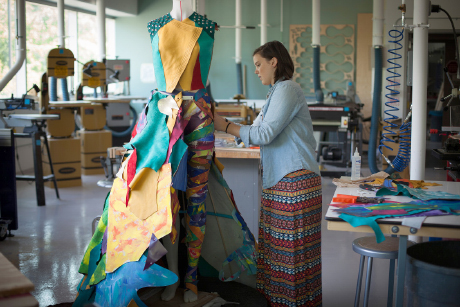Leather dominates student fiber arts exhibition
By Ted Boscia

Leather is in vogue at the Barbara L. Kuhlman Foundation’s ninth Fiber Arts and Wearable Arts Exhibition, a collection of Cornell student creations on display at the Jill Stuart Gallery in the Human Ecology Building through Oct. 24.
Seven Fiber Science & Apparel Design (FSAD) fashioned the colorful pieces, using predominately leather but adding materials including foam, chicken wire, rivets and LED lights. Each year, students submit funding proposals to the Kuhlman Foundation, competing for grants to design wearable and fiber art.
Greta Ohaus ’16 created “Degenerate Debutant,” a gown that represents the relationship between “physical and emotional pain,” she said. Using leather dyed purple and red and mirror shards, her piece explores skin diseases, visible to the world, and underlying mental disorders, such as drug addiction and depression, that may be hidden inside. “I often find what makes my pieces unique is my goal of designing something so sad and often repulsive into something beautiful and intriguing,” Ohaus added.
For “Hued Perspective,” Caroline Donelan ’16 made a patchwork leather gown with strips painted pink, yellow, turquoise, orange and other bold colors. Donelan wants her piece to raise questions about the lucrative leather industry – contrasting harsh conditions for animals and workers and wasteful design processes with growing consumer demands for luxury goods.
“The skirt of my piece is all scraps of leather from a high-end hand bag designer who was going to throw out all those pieces otherwise,” Donelan said. “Not only is there literal waste of hides of leather, but there is so much toxic waste that comes from the chemicals and dyes [used in leather processing].”
For Donelan, the Aug. 26 exhibition opening was “exciting and a great way to share what my piece is all about. I think my piece is intriguing on its own, but when I can explain where each element of the design comes from, people can understand the deeper meaning.”
Ted Boscia is director of communications and media for the College of Human Ecology.
Media Contact
Get Cornell news delivered right to your inbox.
Subscribe